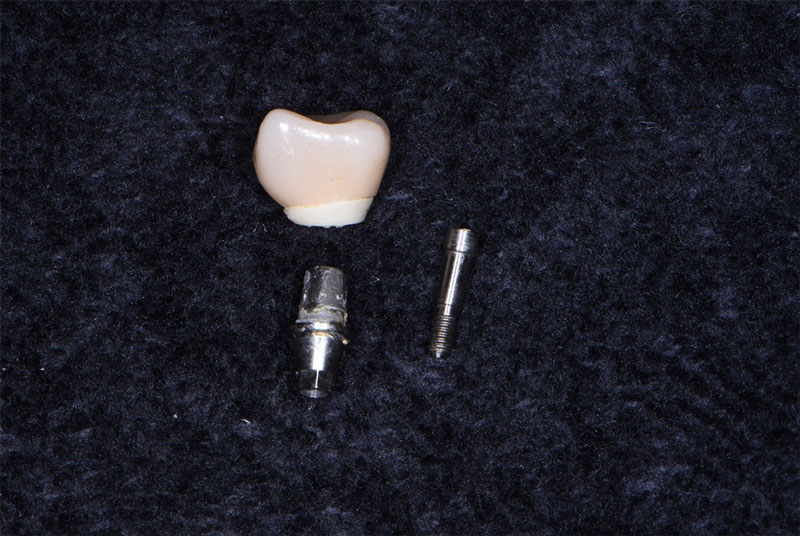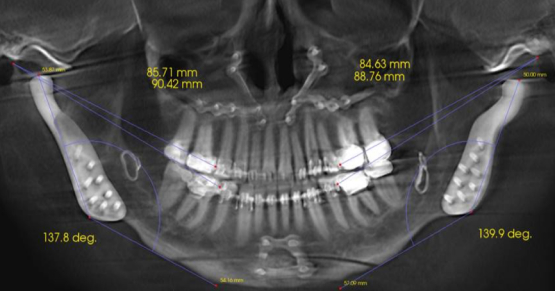Operation Deep Freeze: Removing a Stuck Ti-Base

Unfortunately, sooner or later, we all must deal with retrieving a broken implant abutment or screw. I want to share a new challenge I encountered in my practice the other day, as I am sure other clinicians will have to face this situation at some point.
It started with a patient who came in after his implant restoration was giving him problems because the crown had come off. When we examined the patient, it was quickly apparent that while this was a cemented restoration, it was not the cement holding the crown or the abutment that had failed, but the abutment itself.
In this case, the abutment was a custom abutment that was fabricated using a stock Ti-Base and a custom zirconia mesostructure that had been bonded or cemented to the Ti-Base. The failure was at the bond of the zirconia mesostructure to the Ti-Base. The Ti-Base was still 100% intact. Along with the screw, it was still in the implant while the zirconia mesostructure was out of the mouth and still firmly cemented in the crown.
As I looked at this, I naively thought, ” Cool, this is going to be so easy to deal with,” and “Man, I am so glad something is not broken inside the implant.”
I proceeded to remove the screw holding the Ti-Base in place. As I did so, it came out with no issue at all. At that point, I was even more excited and thinking, “Oh man, this is sweet” and “Now, I am just going to grab it and it’s going to come right out… life’s gonna be so good” and how after it’s out I will clean it and the intanglio of the mesostructure and re-bond the two, make an access hole in the crown and — presto! — We will be back in business with a screw-retained restoration that, at minimum, will be a great provisional and, at best, will continue to serve him as a definitive restoration for some time.
When a Simple Fix Turns Complicated
Well, those were great thoughts, and I can bet you can guess the sequence of events that unfolded next. First, I grabbed the Ti-Base with the normal hemostats in my tray for matrix band removal and gave it a gentle tug, only to get no movement. As you might guess, my next thought was, “Well, I just need to get a better grip and try a little harder,” so I tried that a few more times with the same hemostats. Of course, I still have nothing.
Naturally, my next move was to get a stronger, heavier hemostat. Still, nothing. I began thinking to myself, “Come on, this is not supposed to be this hard,” and “Well, I guess I need something even stouter to grab the Ti-Base with.”
I grab a rongeur. Of course, as I do this, I think, ” Now this is going to do it for sure. Yes, it will mess the ti-base up, but we are getting it off now for sure.” Well, it didn’t help a bit.
Luckily for me, I got one of my great implant reps on the phone who knows his stuff when it comes to implants, and since he worked in a lab for many years, he also knows the restorative and lab side of things well. He had seen this before. It turns out that sometimes Ti-Bases (and I’d guess abutments, too) can get sort of “wedged in,” particularly with implants like Astra, which this happened to be, and Straumann, or even if third-party abutments or Ti-bases are used.
Operation Deep Freeze: The Endo Ice Solution
What was the implant rep’s suggestion? Well, it was to use Endo Ice to freeze or chill the Ti-Base, thereby slightly shrinking it so that those same tugs I had been trying would work.
Guess what? It worked! So, how do you do it? Well, it’s simple. You take a can of Endo Ice and attach the small-diameter tube. Then you spray the abutment, being careful not to freeze or damage the surrounding tissue. It would be very easy to burn or freeze and damage the tissue.
In my case, I actually put the small tip inside the screw access hole of the Ti-Base to ensure I was not going to damage the tissue and to be certain I was getting the Ti-Base hit really well with the endo ice. It is also worth noting that it took several short, controlled sprays (just as my rep advised me that it likely would) for it to work, so if you must do this, be patient. Don’t give up after just a few tries.
Be short, controlled, and deliberate in your application, allowing the spray to work if you don’t let the Ti-Base re-warm fully each time. You will slowly get it colder and colder; eventually, it will shrink enough to allow you to remove it.
While I hope you never need to try this if you find yourself in this predicament, I hope you find this solution helpful!
SPEAR campus
Hands-On Learning in Spear Workshops
With enhanced safety and sterilization measures in place, the Spear Campus is now reopened for hands-on clinical CE workshops. As you consider a trip to Scottsdale, please visit our campus page for more details, including information on instructors, CE curricula and dates that will work for your schedule.

By: John Carson
Date: December 18, 2019
Featured Digest articles
Insights and advice from Spear Faculty and industry experts


